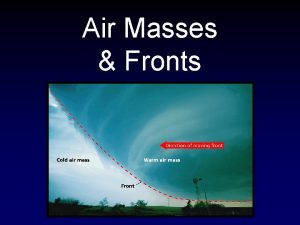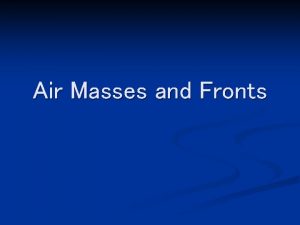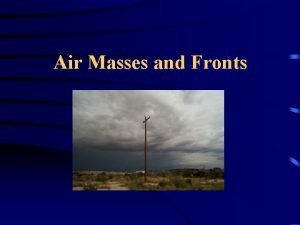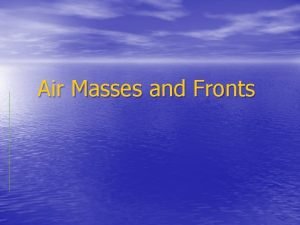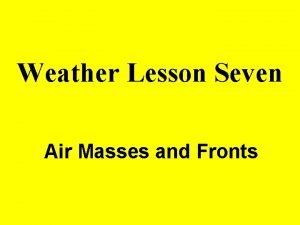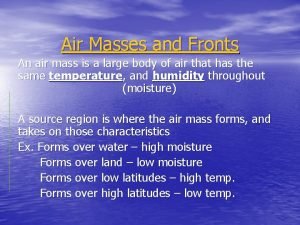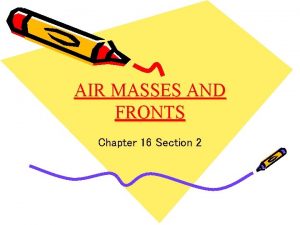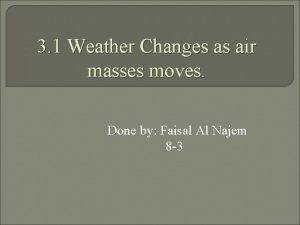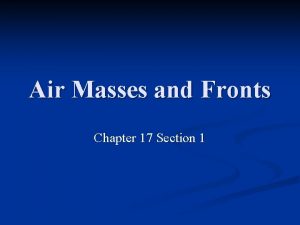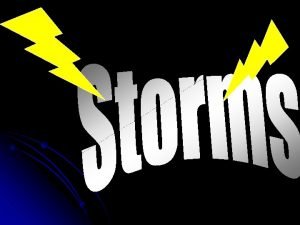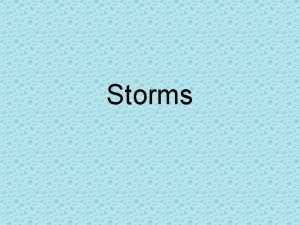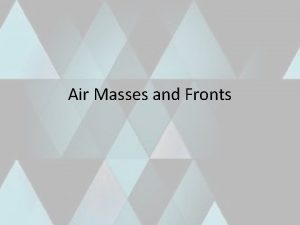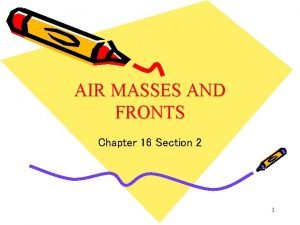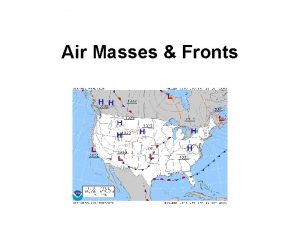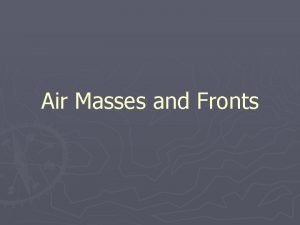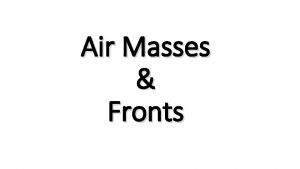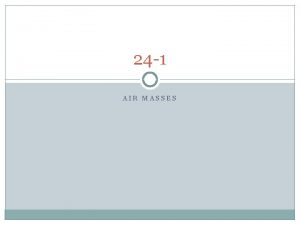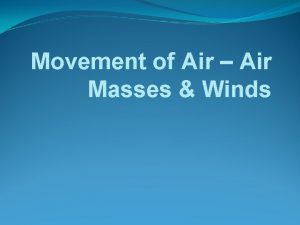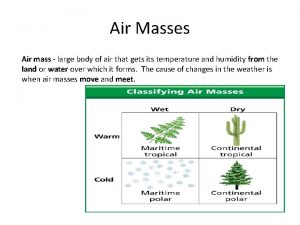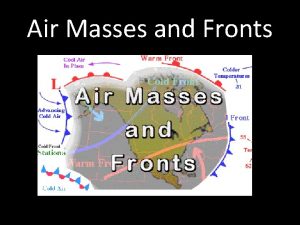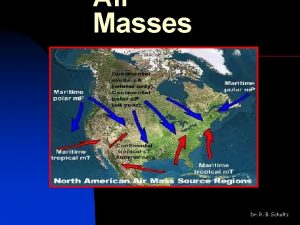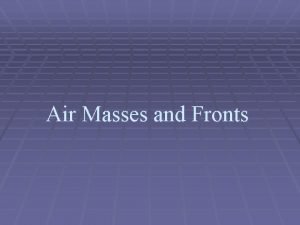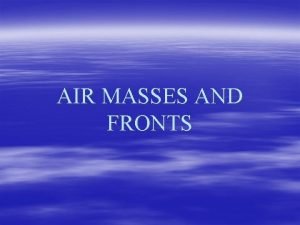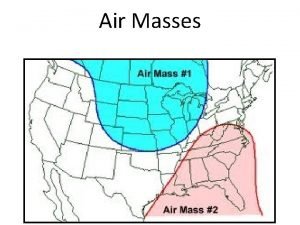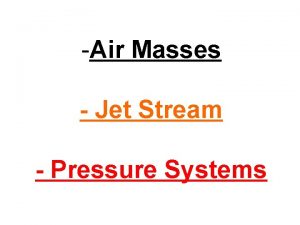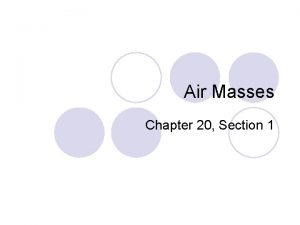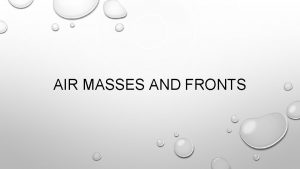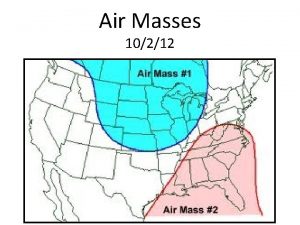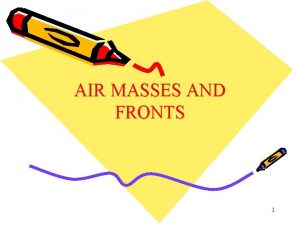What is an Air Mass Air masses are
























- Slides: 24

What is an Air Mass? § Air masses are large bodies of air which have similar temperature and moisture characteristics. § Air masses form when air stays over a region (called the source region) for several days. § Air masses that form over water will be moist, called MARITIME air masses § Air masses that form over land will be dry, called CONTINENTAL air masses

Air Masses § An air mass that forms over a cold portion of the Earth is called a POLAR air mass. § An air mass that forms over a warm portion of the Earth is called a TROPICAL air mass. § An air mass that forms over an extraordinarily cold portion of the Earth is called an ARCTIC air mass.

SOURCE REGIONS - WHERE AIR MASSES ACQUIRE THEIR PROPERTIES Air Masses are Classified According to: Surface of source region Continental (c) Forms over land - dry Maritime (m) Forms over ocean - moist Temperatures Tropical (T) -Low latitudes - warm Polar (P) - High latitudes - cold Arctic (A) - Poles - very cold and dry

§ § c. T c. P m. T m. P Continental Tropical – dry & warm Continental Polar – dry & cold Maritime Tropical – humid & warm Maritime Polar – humid & cold § c. A Continental Arctic – very dry & very cold

NORTH AMERICAN AIR MASS SOURCE REGIONS


§ The general movement of the four main types of air masses that influence the weather over the United States. The tropical air masses visit most often in the summer, and the polar air masses visit most often during the winter. During other times, the polar and tropical air masses battle back and forth over the land.

§ Storm tracks across the continental United States From West to East. This makes it possible to predict What weather is coming our way.

FRONTS § Fronts are boundaries that separate air masses § There are four types of front: – Stationary front – Cold front – Warm front – Occluded front

Go to page 13 of your ESRT!

Fronts – boundary that separates 2 different air masses § Either a warm front is advancing or a cold front is advancing.

COLD FRONT § § § Cold air replaces warm Much steeper than warm fronts Advances faster than warm front More violent weather -cumulonimbus clouds Short, sharp showers

Cold Front § A cold front occurs when a more dense air mass pushes under a less dense air mass – short– lived thunderstorms

WARM FRONT § § § Warm air replaces cold Gentle slope Covers a wide area with its weather Stratus clouds get lower as front approaches Drizzle or steady rain

Warm Front § A warm front occurs when a less dense air mass rides up over a more dense air mass – longer, steady precipitation

STATIONARY FRONTS § Cold and warm air masses next to each other § Neither air mass advances

Stationary Front § A stationary front occurs when the air masses on either side of the front are not moving toward each other.

OCCLUDED FRONTS § § § Cold front overtakes the cool front Lifts the warm air off the ground Clouds and rain possible

Occluded Front

Air rising and cooling to the dew point by expansion (adiabatic cooling) By forced lifting—such as when less dense warm air is forced above more dense cold air (when two air masses meet)

Kinds of Fronts § § Cold Fronts Warm Fronts Stationary Fronts Occluded Fronts

A continental polar air mass comes down from Canada and meets a maritime tropical air mass from the Gulf of Mexico. Watch the cloulds form.

Air rising and cooling to the dew point by expansion (adiabatic cooling) By convection: The Sun heating the ground (by radiation), which then heats the air above (by conduction), which then rises due to convection (is less dense than the cooler air surrounding it. ) Picture from the National Audubon Society Field Guide to Weather

Air will rise when it is heated, because it will become less dense. Air moves in to replace the air that rose up. The converging air will further rise. As it rises, it cools and water vapor will condense. This will release latent heat, and further heat the column of air.
 Cold front air movement
Cold front air movement Air masses & frontswhat is an air mass?
Air masses & frontswhat is an air mass? Air masses & frontswhat is an air mass?
Air masses & frontswhat is an air mass? Stationary front
Stationary front The boundary between two adjacent air masses is called
The boundary between two adjacent air masses is called Two cold air masses converge on a warm air mass
Two cold air masses converge on a warm air mass Air masses & frontswhat is an air mass?
Air masses & frontswhat is an air mass? Insidan region jh
Insidan region jh Cold air mass overtakes warm air mass
Cold air mass overtakes warm air mass A swirling center of low air pressure is called
A swirling center of low air pressure is called Air masses
Air masses What are the five types of air masses?
What are the five types of air masses? Air masses and their characteristics
Air masses and their characteristics How to draw cold front
How to draw cold front Air masses
Air masses Warm hall
Warm hall Continental arctic air mass symbol
Continental arctic air mass symbol Air masses form in the tropics and have low pressure
Air masses form in the tropics and have low pressure Air masses
Air masses Area of low pressure where air masses meet and rise
Area of low pressure where air masses meet and rise What letters designate an air mass from the gulf of mexico?
What letters designate an air mass from the gulf of mexico? Large scale rotating air mass
Large scale rotating air mass What are middle-latitude cyclones?
What are middle-latitude cyclones? Air fronts
Air fronts Air mass mt
Air mass mt
